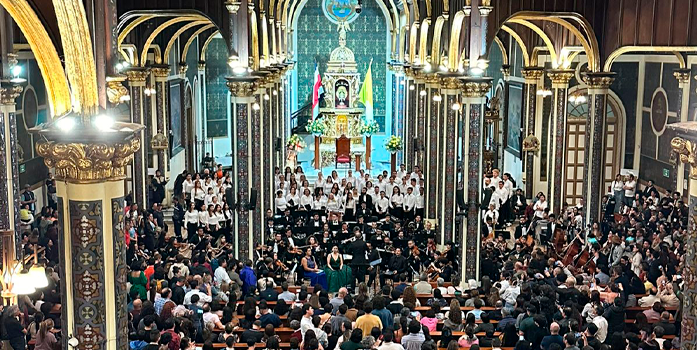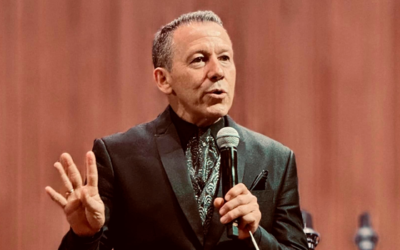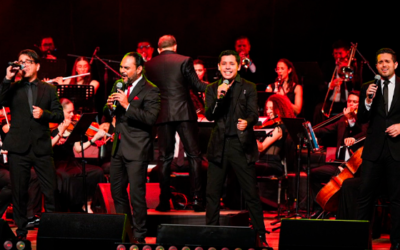Speaking or writing about Beethoven always proves fascinating due to the singularity he embodies, not only as an individual but also through his life and music. This uniqueness simultaneously poses a challenge when attempting to comprehend and interpret his works or when trying to share relevant aspects of his legacy.
From a symphonic-orchestral standpoint, Beethoven could have perfectly composed only eight symphonies, and the world would have been deeply grateful and satisfied with this inheritance bestowed upon us just over two hundred years ago. His works are imbued with innovation, originality, character, expressiveness, and contrasts, alongside an incomparable compositional technique and orthodox ruptures in form and content. These characteristics granted him a status of immense artistic, public, political, and social value.
Yet, his works are also laden with emotional content reflecting not only the great composer Beethoven but also the human being Beethoven, with all its ups and downs. Sometimes depressed, sometimes brimming with life, but always with a fighting spirit. An internal and personal struggle against his hearing impairment, a struggle to recover from unrequited loves, a struggle against hostile family moments, a struggle in favor of his political ideals, and a struggle to achieve his personal and artistic ideals.
Much of Beethoven’s unique style throughout his oeuvre is linked to the natural and organic development it underwent over the years. Each symphony organically guides us toward its ultimate and highest artistic, philosophical, and spiritual purpose. His greatest purpose as a human being was to invite us, beneath this vast celestial vault, to embrace each other as brothers and sisters. Therefore, Symphony No. 9 Opus 125 in D minor represents an emotional climax of great majesty while offering us a synthesis of his own life story.
The first movement commences with neutral and timeless sounds. A fifth interval between the horns inspires a sense of freedom in time and space, gradually leading us to a thunderous moment that prompts reflection on the human condition, and its experiences throughout life with moments of anguish and pain alternating with moments of joy and happiness.
The second movement is a Scherzo, traditionally in music a Scherzo bears a marked character of dance and play. In the second movement, Beethoven invites us to enjoy the good things in life. He makes life more joyful and entertaining. It’s not a short Scherzo, as traditionally presented. In this case, he repeats it as if wanting to prolong a moment of happiness because he doesn’t want it to end.
The Adagio of the third movement is the slowest and, from my perspective, the most difficult to interpret, just as difficult as the inner transformation of us as human beings. The music of this third movement is laden with spirituality and invites introspection, to find ourselves and initiate our process of transformation towards freedom, brotherhood, and openness to others, to embracing others, which was Beethoven’s desire throughout his life and which he encapsulates in this symphony using the powerful language of music.
The Finale is what everyone eagerly anticipates, as it contains the famous theme of the “Ode to Joy.” However, this finale makes more sense when one lives and internalizes the entire process of the previous three movements, especially the third, which urges us towards the aforementioned internal transformation, and in some way prepares us for the fraternal embrace among all human beings that Beethoven envisioned.
As a young man, Beethoven already wished to utilize Friedrich Schiller’s poem, which speaks to the need to love and embrace each other as brothers and sisters; however, he was never prepared to do so. He had to go through a long process, sometimes tormenting, sometimes very gratifying, sometimes dark, sometimes not so terrible, sometimes almost touching the sky of joy. That process that we all experience and that teaches us and reveals its secrets day by day. That process is called life. In other words, Beethoven had to go through the university of life before he could write his message to humanity with the powerful language of music.
The final movement begins with a thunderous fragment to put us in a state of complete attention and deliver its message of joy. A message of hope for all human beings to become brothers and sisters again.
Beethoven elevates us to the highest summit of our human capacity to continue his discourse on another even more celestial level. The contemplation of God and a kiss that encompasses the whole world.
From a technical, musical, and artistic analysis, the work is perfect and represents the culmination of the “symphony” as a genre during the first half of the 19th century. Few composers chose to continue writing symphonies after this masterpiece. Their technical, expressive, and innovative attributes were sufficient to fully achieve their artistic purposes. However, it is the spiritual message and the humanitarian communion that make this work remain so relevant two hundred years after its creation, and I am sure it will continue to be so for many more decades.
The massive attendance and the deeply emotional reaction of the audience at the OSUCR concerts this past weekend – Parroquia de Barva de Heredia on Friday, May 10, and Basílica de los Ángeles de Cartago on Sunday, May 12 – in celebration of the bicentennial of the composition, are a faithful reflection of the strong artistic, humanitarian, and spiritual values of this wonderful work of art.



